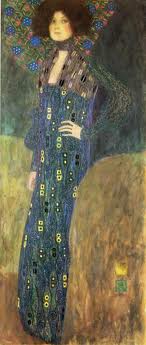Most of what I have found out is from
www.gustav-klimt.com
But also the virtual Gustav Klimt museum: Click here to go to the Klimt museum
He was born in 1862 in Vienna. He was the second of 7 children of a professional craftsman. He only got to the Art and Craft School because he won a scholarship. He was not therefore one of those gentleman artists who could explore their own truth without worrying about money. He worked as a specialist interior decorator in Vienna with his brother and another colleague from art school.
 |
| Klimt design for a theatre curtain Karlsbad 1886 |
 |
| Klimt mural for the Burgtheatre, Vienna Shakespeare's theatre/ Romeo & Juliet |
So he started off as an interior decorator of a very high class type, after a good solid education in classical art, and was a great success. However, he became interested in Art Nouveau during this period, and in 1897 some other artists formed a society known as the Secession, specifically set up to protest about the restrictive nature of the classical art establishment at the time. He was the first president.
He experimented with Japanese, Chinese, Ancient Egyptian, and Mycenaean art. (The first 3 at least I think are more 2D decorative - I don't know about Mycenaean art)
He was commissioned to decorate the University of Vienna, and produced murals which no longer exist having been destroyed in the war - black and white photos were taken at the time...
 |
| Klimt mural - Philosophy |
 |
| Klimt mural - Jurisprudence |
 |
| Klimt mural - Medicine |
According to www.gustav-klimt.com he was 'criticised severely for their radical style and for what was, for the standards of the time, their lewdness.'
(You might say he was going all out to shock his audience. I'm quite shocked when I put these next to, for example, John William Waterhouse's Destiny, painted in the same year. I partly chose this because of the pre-Raphaelites insistence on doing classical better than the establishment.
Or next to the depiction of a young woman in the same year, 1990, by the classical court painter to the Austrian Emperor at that time, Friedrich von Amerling...
Which of these is more decorative? The classical/ pre-raphaelite or the Klimt?
No question that the Klimts are not as 'decorative'.
This makes me question the definitions I have in my head of 'High Art' and decoration. Surely these Klimt murals are complicated, emotionally expressive, potentially revolutionary by making you think unthinkable things about the establishment.)
Starting in the 1890s he took holidays in the Attersee, and produced a large number of landscapes, which commentators say are very flat, and one suggests he looked through a telescope to paint them. I don't know which of the paintings I can find online relate to this, but the apple tree looks pretty flat to me.
.+Apple+Tree+I+1912+.jpg) |
| Klimt - the apple tree 1912 (from Wikipaintings) The important thing seems to be the colours. |
 |
| Klimt - Avenue of Schloss Kammer Park This one struck me as having very sinuous trees A bit Van Gogh-like. |
 |
| Klimt - birch in a forest - wikipaintings I love the texture of the bark, and the solidity of it. The background is 2D |
Golden Phase 1897-1910
This is the period that has been so popular this century, with lots of gold leaf. I have some examples here, but there are more, of course.
 |
| Klimt- the kiss you can see some of the interesting use of colour from his landscapes in the grass, and the use of decoration in the foreground (as opposed to the background as is generally done) |
 |
| Klimt - Danae 1907-8 Great composition, and of course fantastic portrait painting. |
1910 onwards - He stopped using so much gold. For example, in 1912 his Life and Death won first prize at the international exhibition in Rome.
 |
| Klimt - Life and Death |
In fact, the background was gold at the time, but he was dissatisfied with it and changed it to blue after the event.
 |
| Klimt - Expectation 1909 Klimt said this was "probably the ultimate stage of my development of ornament." |
 |
| Emilie Floge in a dress said to have been inspired by mosaics |
He is said to have designed many of her clothes, and there are some photos of her, but it never seems to say who designed them.
 |
| Klimt - Portrait of Emilie Floge I like the two squares of colour in the bottom right hand part of the painting, balancing the strange peacock collar. |
Doing this page has made me think about decoration and ornament.
That decoration can take parts of a painting into the background.
That Klimt used bright regular shapes to represent natural textures.
That some of these paintings may be seen as obscene, even now 100 years later. Perhaps shocking is ok if its done REALLY WELL! (Or by someone who's already famous).
That even great painters try out different styles and techniques - perhaps that's what makes them great in the end.
It has made me think I could try out more decorative things, as opposed to realistic things. That not everything has to have a meaning.
That composition is even more important than I thought.
And that making art might be even more fun than I thought.
And that making unusual or experimental clothes is an all right thing to do in my spare time!




No comments:
Post a Comment